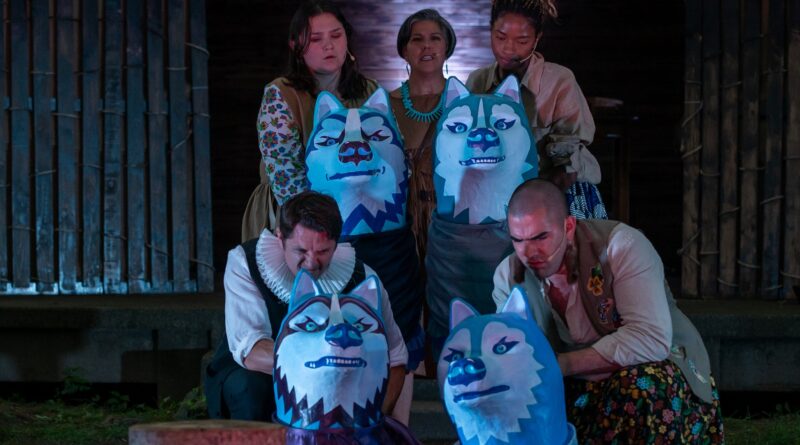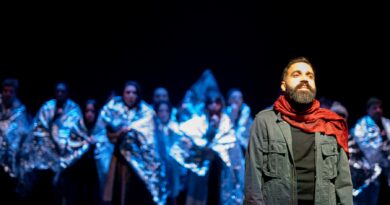“This is a love story”: Shakespeare in Action’s otîhêw re-imagines Shakespeare’s Othello
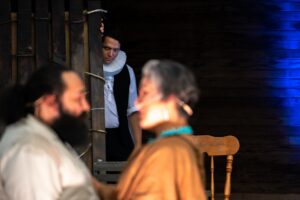
PJ Prudat’s otîhêw, currently being performed by Shakespeare in Action at Little Memorial Park in Weston, is a Cree-Métis reimagining of Shakespeare’s famed tragedy Othello. It re-locates the play from Venice, Italy to a north western factory fort along the Saskatchewan river in 1816.
This place and this time are a crucible of environmental and colonialist pressures. It is “the year of no summer”, when the massive eruption of Mount Tambora in Indonesia spewed ash and dust that blotted out sunlight around the world, triggering a volcanic winter that reduced temperatures, caused crops to fail, and deepened conflict over scarce food supplies.
It’s the height of the Pemmican War – waged in the north west between duelling settler trading companies. The Hudson Bay Company seeks to restrict the trade of pemmican, vital to indigenous and settler economies as both food source and trade commodity. Allying themselves with HBC competitor the North West Company, the Metis population battle the HBC to keep trade open and pemmican available. After the play opens, we hear report of the bloodiest and culminating battle of this war, in which the HBC were defeated, and their governor was killed. And if all this is not enough, other colonizer-introduced ills loom: pandemic in a resurgence of the originally blanket-born smallpox that devastated indigenous populations, and alcohol, the second pandemic to wreak havoc on indigenous populations.
Otîhêw not only relocates the play’s action to this intense North American setting, it complexifies the main characters by reimagining their race, gender, status and agency by introducing intersectional nuance. Shakespeare’s black general Othello, who is the subject of racism even as he leads the Venetian army and faithfully serves white aristocratic interests, is gender- and race-swapped into “our matriarch otîhêw” (Nicole Joy-Fraser), the strong and caring Métis leader who seeks to lead her people through these times when “The world is upside-down.”.

Shakespeare’s Desdemona, white daughter of a Venetian senator, who secretly marries and is ultimately murdered by Othello, becomes otîhêw’s husband Desmond (Spencer Bennett), to whom otîhêw is bound in the historical “custom-of-the-country”. Desmond is not white: he is an Afro-Indigenous fur trader. But because he is the fort’s Chief Factor (the official appointed by white trading interests to oversee all social, economic and political aspects at the fort), this “mixed man living in a white man’s way” is functionally a white man with the attendant status and power.
As the play opens, the bond of Desmond and otîhêw represents a union of the indigenous and white power structures in this volatile setting – something which angers otîhêw’s brother Hamish (Jonathon LeRose). The play’s version of the villain Iago, he sets in motion a manipulative scheme to take for himself both ”her place and his”. In attitude, syntax and relish for scheming, Hamish is most like his Shakespearean predecessor, which is underscored by the Elizabethan ruffle he wears. But while his unctuous manipulation and mocking refrain “Am I such a villain?” sound a lot like Shakespeare’s inscrutable and malevolent white evil, Hamish is more complicated. Half-indigenous and half-Selkie, he shares a blood connection to otîhêw and has a role in the white world as leader of the fort’s guard.
The play’s three remaining characters also stand in between worlds and straddle loyalties.The tortured Inés (Jewell Bowry), who becomes ensnared in Hamish’s scheming, is a black woman brought against her will to the fort, where “I see no reflection of myself”. She does not know how to put down roots here, though there is some urgency to do so. The two-spirited translator Solomon (Raymond Jordan Johnson-Brown) has deep insight and skill that help him navigate and negotiate difference. “I see you”, he tells Inez, whom he aids. But he, too, is the target of Hamish’s manipulations. And Birdie (Brefny Caribou) is a self-described “dog of earth” – a Métis orphan mentored by otîhêw.
Literally and metaphorically, the world of otîhêw is much less black-and-white than that of Othello. As the play opens, the actors – serving as a chorus – pose complex questions that reverberate through this complex setting: “Where do you stand?” “Who is beside you?” “Who is with you?”. The intertwined and variegated origins of these characters – not to mention the hostility of the environment in this “year of no summer” – make answering these questions both challenging and urgent. Each character will do so, and choose their actions accordingly.
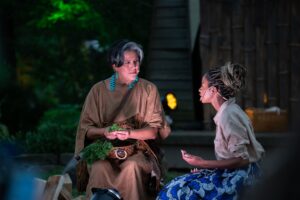
Near the play’s start, we are also told by the chorus, “This is a love story”. And we should remember this, especially when things seem most dire and Othello-like. Early in the play, otîhêw and Desmond re-tell the story of their first meeting – when this paddling fur trader’s energy of colonization was transmuted – by her strength and laughter, and his openness and song – into enduring connection and partnership. The beauty and sincerity of that meeting – and the love it engenders – reverberate throughout the play. So spoiler alert: otîhêw is emphatically NOT a tragedy. If you’re looking for a pile of bodies caused by the hubris of a great man and the shortfalls of his society, you won’t find it here. And we are told so from the start.
In this dynamic setting with its clash of cultures and intersection of identities, there is strong potential for dark outcomes. But there is strength to be found in the diversity of these characters. And there is levity to be tapped – in the form of otîhêw’s lovable huskies: blue puppets operated and voiced by the actors, whose canine quibbling brings welcome laughter, but whose actions as a pack show unity, providing critical aid to otîhêw in her trips to the wilderness. And in Joy-Fraser’s serene, compassionate and radiant otîhêw”, there is wisdom, empathy, and access to medicine – and deep insight – gleaned from her connection to Mother Earth. otîhêw may not understand that insight right away, but eventually, she will. She is told, “You have to go through – you can’t go around.” And we watch her do just that, in a time-twisting fashion that leaves us filled with wonder and surprising hope.
I want to say more – much more – about this wonderful play, the actors’ sneaky-good performances, and Lisa Nasson’s skilled direction, but I am conflicted. I don’t want to spoil the plot. Yet I feel tempted to try to explain exactly what happens . . . because the multi-layered setting, the thematic density, the often-poetic syntax, the complex intersectional realities of the characters, and the indigenous mythological backdrop can make aspects of the plot challenging to follow. For instance, the play’s ending is deeply inspiring and a bit mysterious.To make sure I understood this resolution – where the play departs most significantly from the earth-bound reality of Othello – I returned to watch a second performance of otîhêw. It occurs to me that audiences might benefit from the addition of a simple plot synopsis to the play’s digital program. It would spoil what happens . . . but it might free some spectators to focus more of their energy on the performances and the play’s resonant message.
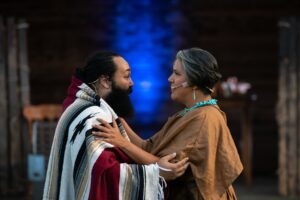
In any event, this suggestion is not a critique of the play, the direction or the acting – all of which are rich and engrossing. And Weston’s Memorial Park is a jewel of a setting. This tree-lined and breeze-blessed park sanctuary above the Humber River features lots of green space to relax in, plus a rustic stage that has been cleverly adapted for otîhêw. It’s easy to imagine yourself in the play’s north west wilderness setting . . . but this liminal space is bounded on one side by a road marked by car traffic and noises. These prevent our total immersion and remind us that the dynamics of otîhêw continue to play out right here, right now, all around us.
“This is a love story” movingly told and earnestly acted. And we need it more than we need a 400-year-old tragedy.
© Scott Sneddon, Sesayarts Magazine, 2023
About The Author
Scott Sneddon
Scott Sneddon is Senior Editor on SesayArts Magazine, where he is also a critic and contributor.
Visit About Us > Meet the Team to read Scott’s full bio …

